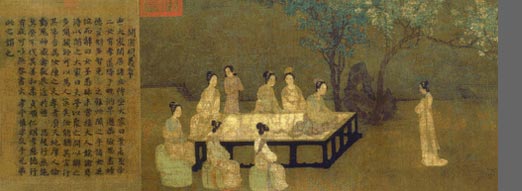|
Environmental Conditions
Humidity will vary between "Too High" at a Relative Humidity (RH) of 70% to "Too Low" at 30% RH. It is important to minimize the fluctuations as much as possible because with every change all the wooden members, that together make a piece of furniture, will move independently. Wood expands in its width and thickness (across the grain) but makes no significant adjustment in its length (along the grain). Rapid daily changes are very much less of a concern than are those created seasonally, especially since the advent of central heating.
Museum and other owners of large collections of furniture strive, with the aid of humidity control machines, to maintain an even RH. People in the private sector should also try to emulate the "professionals", but only if the quality of their antiques warrants both the expense and trouble of maintenance that humidifiers and dehumidifiers demand. In periods of extreme dryness wet cloth draped over radiators or purpose made "humidity wicks" hung on them, may make a modicum of difference. It would be more effective to lower the background temperature and use local heat only when necessary.
Cold Outside + Warm Inside = Dry Conditions Shrinking timber causing opening-up of the joints, warping, splitting & cracking and torn veneers.
Warm Outside + Cool or Warm Inside = Damp Conditions Expanding timber causing Warping and Compression Stresses - internal damage to the cell structure of the wood, which adds, in time, to additional shrinkage.
A warm and damp environment accelerates chemical action. Materials which become chemically unbalanced, such as leather (particularly of the late nineteenth and early twentieth centuries), paper and textiles are at risk. A damp environment will cause dust-covered metals to be severely damaged. Marble too can become stained from dust in similar conditions. Bronze mounts are susceptible to Bronze Disease, the appearance of blue/green copper on its surface, in a warm damp acid environment.
All light and daylight in particular, contains Ultraviolet light - the wavelength of light that is most damaging to colours of both dyed and natural woods and textiles. Direct sunlight also heats up the parts of objects it falls upon. This warm dry microclimate is evidenced in damage to surface coatings, veneers and the underlying adhesive. The exposure of Oriental Lacquer to daylight should be kept to a minimum, while the whiteness of ivory may be enhanced by shaded daylight.
Biological Conditions
The common furniture beetle (Anobium punctatum) is, or has been, more responsible for rendering furniture unsafe than perhaps any other factor. Fortunately today, eradication of the pest is relatively simple. There are three systems currently used :
Brushed, sprayed and/or injected liquid insecticide
Enveloping the object in a gas, either as a direct poison or as a means of excluding oxygen.
More recently a heated humidity controlled environment has been used with excellent results.
Occasionally furniture has been infested by the deathwatch beetle (Xestobium rufovillosum). The insect needs damp wood which supports a fungal growth, which in turn makes the wood digestible, before it can set up home.
The prolonged causes of dampness in buildings permits the onset of fungal growth. If these conditions are permitted to extend to the furniture within them, these too will become susceptible to fungal attack. Fungus, in this situation will cause staining and also weaken the adhesives. A fine whitish "growth" is sometimes found on or in furniture where damp conditions may not be suspected. This can be a mild type of fungus but is more likely to be some form of crystallisation. In both cases the deposit may be brushed off and wiped away with a dry cloth.
Human Intervention
Events over a period of time impart a unique quality to each piece of furniture, and it is primarily people's intervention that has and is governing each item's acceptability. It is the Restorer's privilege to make acceptable those items that have been subject to unfortunate circumstances.
The aim of the custodian, for that is what we are when we have antique furniture, is to maintain its good health. Furniture that has been with the family for a decade or more and not caused concern is unlikely to present problems providing its past treatment is unchanged. However, a newly acquired item may be subjected to a considerable change to its environment, therefore we should not be surprised if movement occurs within the piece. Unless there are already significant tensions between the structural units, damage resulting from the move may not happen for several months. Conversely the new environment may be a kinder place.
Moving Furniture
Much damage occurs when objects are moved. This can be avoided if the item's construction is wholly understood. Failing that there are a few simple rules that will help avoid embarrassing moments:
Furniture should be lifted by its strongest units or rails: chairs, including arm chairs, by their seat rails, tables, by the rails/frieze below the top or by the legs., cabinets and chests by their lowest rails or at "foot level" and not by the top.
In principle NEVER DRAG furniture, not even for an inch/centimetre. In practice, if there is no alternative, then the dragging force must be as close to the floor as possible.
Preventing Surface Damage
The main causes of surface damage are:
Liquids of all sorts, excessive heat and scratches and bruises.
Unless there is a mat providing softening under a heavy object or vase never slide it; it will scratch. If the mat is absorbent it may trap spilt water under a vase. A damp seal - polyurethane perhaps - needs to be put between the mat and the wooden surface.
Spilt water and water based liquids should be wiped off to prevent them spreading and the surface rubbed dry. Spirits and other solvents must be dabbed off to prevent them spreading and should not be rubbed dry, lest they have softened the surface finish which could then be deformed/marked. A common and very defacing bruise is caused by drawing with a pencil or writing with a ballpoint pen on paper with no softening between it and the wooden surface.
Removing any bruises from polished wood, without removing the surface is seldom possible and any process carries considerable risk of damaging the patina and changing the surface colour. Not only will the direct sun's rays overheat furniture, they will cause severe bleaching of the wood and make the polish cloudy. Drawing the curtains until the sun has passed is the simple remedy. It may be argued that the opaque polish, caused by the water soaking into the top, or by too much local heat, and the scratches and bruises are part of the history of the object. Realistically these are elements of history that are generally best forgotten, even if the experience of their occurrence is a valuable lesson. In each of these accidents it is best not to compound the problem with trial and error remedies, but seek help from a convenient BAFRA Member.
These then are the prime causes of deterioration of furniture and with them, a few suggestions which may help to retard the inevitable aging process.
|

